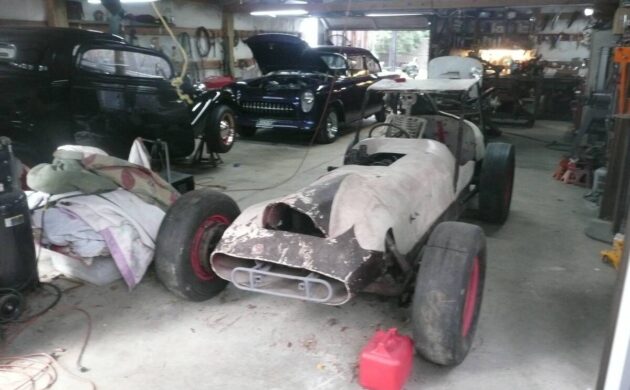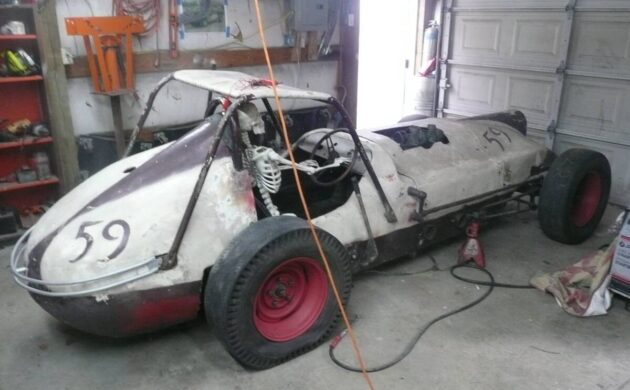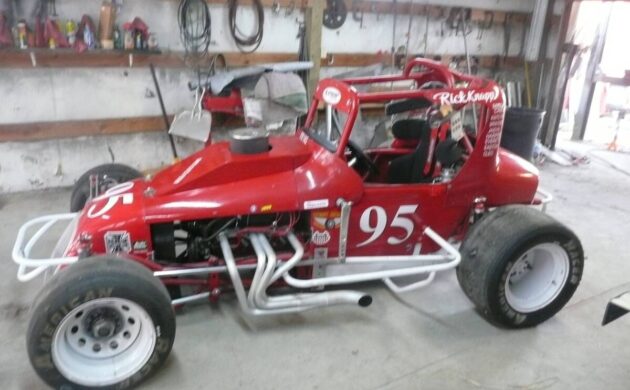Seeing the photos of these vintage sprint cars brought memories flooding back for me. It has been a few years since I hung up my helmet after racing a wingless sprint car, and I still miss the thrill. My racing days are now behind me, but someone has the chance to experience the joy of vintage racing. They can choose from two cars. One is begging for restoration, while the other is ready for immediate action. The seller listed them here on Craigslist in Spanaway, Washington. The project car will set you back $3,000, while the race-ready one is a steal at $7,500. If either is too rich for your blood or you’re struggling for space, the seller will entertain possible trades. I must say a big thank you to Barn Finder T.J. for rekindling some great memories.
The history of these classics is unclear, but the seller indicates this sprinter hails from the 1960s. It appears essentially complete, but it requires some love. Dismantling these vehicles is easy, as they are designed for rapid parts changes due to the ever-present danger of racing damage. If the frame is undamaged, sending it to be media-blasted and powdercoated should return it to as-new condition. The fiberglass panels look okay, but the buyer needs to source a seat and a few other items. Current regulations would specify a full containment seat and a five-point harness, but the pair should cost around $1,000. It appears there is an engine under the hood, but it is unclear what type. It is probably a V8 and depending on when it last competed, there’s a good chance it is a Chevrolet small-block. This sprint car ticks the right boxes if someone is seeking a hands-on project.
The second car is a race-ready sprinter built in 1973. Apart from the distinctly different body styles, the first thing to note is the additional nerf bars on both ends and sides. The rear helps protect the fuel tank, which is good considering the driver has up to twenty gallons of methanol sitting against the small of their back! The side nerfs help reduce the risk of wheels interlocking because that’s an excellent way for the unwary to experience the unpleasant “sky, ground, sky, ground” syndrome. That is rarely fun, but it is an accepted part of racing. The panels look excellent, the paint shines nicely, and this car features a full containment seat and harness. Examining this sprinter reveals a few noticeable evolutionary changes beyond the extra bars. The frame and integral roll bars look far more robust than the project car. However, I’d wager they are regular steel rather than the 4130 Chromoly used today. The wheels are center-locking, rather than the five-stud variety seen on the other car. Under the hood, we find a small-block, while the corners feature new coilovers. That is another notable difference to modern sprint cars that almost exclusively utilize torsion bars. The vehicle last competed earlier this year, and the seller is happy to kick its V8 into life for interested parties.
Affordable project cars will always generate interest, and with the growing popularity of classic racing categories, this pair of vintage sprint cars should be no exception. The question potential buyers need to ask themselves is which would they choose. The race-ready car is tempting while returning the older sprinter to its former glory should be rewarding. They would qualify for separate categories, so buying the pair could be a great move to double your fun. The only note of caution I would sound is that sprint car racing is addictive. Once you’ve tipped one of these vehicles into a corner on the razor’s edge and felt them scrabble for traction as you apply the power, you can’t get enough of it! I speak from experience and can tell you that passion never dies. Still, I can think of worse ways to spend a Saturday night.






It would be wise to research the 1960 project if only because many of these cars were USAC sanctioned; Parnelli Jones, A.J. Foyt, and many famous racers in the day ran these cars.
Would even make a great display piece.
Dang if I’m just too far away or I’d be heading north…
These POSs are hardly USAC material.
I wonder if the ’73 originally had magnesium wheels. A buddy of mine raced during that period, and all the serious guys ran mag wheels. Regardless, that’s a great price for a runner.
These are low budget, homemade racers and hardly good examples of vintage sprinters. I should know, my father Ted Wise, raced sprints for 30 years around OH/PA/WV. He raced with Ryan Blaney’s grandfather Lou Blaney (Dale/Dave’s father) around Western PA for many years.
Lou could pedal these things!! Blackie Watt and a few others made Friday nights fun at Lernerville or Motordrome…
The red one looks like a sprint car that was converted to a supermodified back in the late sixties early seventies.
I was going to say it was a supermodified trying to be a sprinter. Offset chassis and slicks point to pavement racing.
I am imagining a “track” up and around the backyard, over the neighbors driveway, straight out the cul du sac to the one across the street, hairpin and back. Huge fun. The whole neighborhood would kill me – risk\reward. Okay, back to wondering about my lap times. With practice I could shave it down, but then better tires or fuel injection would be the next step. I’m just ignoring the obvious…
Hope your life insurance is paid up!
Now about that black ’30s street rod in the background….
Here’s a fine example of a vintage sprinter for yah.
https://www.racingjunk.com/sprint-cars/184359556/1976-trevis-craft.html?category_id=429&np_offset=22#5
Floyd Trevis was a notable builder and Sprint Car Hall of Fame member. His shop was in Youngstown, Ohio.
My father drove Charlie Alfater cars. Charlie was a Indy mechanic turned sprint car builder. He had a small shop at his house in Brecksville, OH, near Cleveland. The 2 car was sponsored by Mike Garcia, a prominent Cleveland Indians pitcher back in the day. It was often in the winner’s circle.
https://www.facebook.com/CharlieAlfaterSprintCars/
Lee. Why jump all over every bodies comments? Just obnoxious.
Personally I’d take the project car.